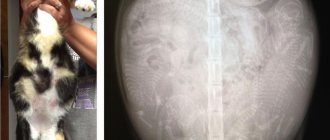Signs of pregnancy in dogs
Many owners ask what are the signs of pregnancy in a dog.
There are no signs of pregnancy in a dog in the early stages. At this time, it is impossible to determine whether the bitch will have puppies, either by palpation or by appearance.
The first signs of pregnancy in a dog after mating concern not physical condition, but behavior. The dog may become calmer, more affectionate, and sometimes show signs of illness.
Signs of pregnancy in a dog most often appear 21–22 days after mating. At this time, if you know where to look, you can feel small lumps on both sides of the abdomen. These lumps can be felt until the 35th day, and later become soft, so that they can be felt with difficulty. But by this time, signs of pregnancy include an enlarged belly.
By the 4th - 5th week, signs of pregnancy in a dog include thickening on the sides, the body becomes rounded. But sometimes these signs of pregnancy in a dog are visible only at the 7th week.
During the 5th week, enlarged nipples are added to the signs of pregnancy in the dog, and in the 6th week, if the bitch lies on her side, puppies can be felt in the horns of the uterus. A sign of pregnancy in a dog at the 7th week is a significant enlargement of the mammary glands. In the last week, a drooping belly is added to the signs of pregnancy.
One of the surest signs of pregnancy in a dog is the movement of the puppies.
What changes occur in the second month of pregnancy
The dog's belly enlarges, the mammary glands swell and darken, and viscous mucus may be released from the loop. The pet becomes less active and quieter, and its appetite increases. Starting from the 50th day, the puppies can be seen moving.
After 50 days of pregnancy, the female begins to look for a secluded place for herself and her puppies. Owners should monitor the nesting and find a cozy corner for the pet. If your pet's size allows, offer her a large cardboard box lined with moisture-absorbing diapers. Keep in mind that in such a “kennel” the dog will spend a lot of time with the puppies; there should be enough space for everyone. If necessary, trim one side to make it easier for your dog to enter his shelter. Be prepared for the fact that your pet will drag your “nest” to another, more convenient place for her. You'll have to come to terms with this.
How to detect pregnancy in dogs at home
You can determine if a dog is pregnant at home by the following symptoms:
- Changes in appetite (during mid-pregnancy, the dog usually loses his appetite).
- Vulvar discharge (4th week of dog's pregnancy).
- Decreased dog activity level.
- Enlargement of the dog's belly.
- Enlargement of dog's nipples.
How else can you tell if your dog is pregnant? There are additional ways:
- Pregnancy test. However, please note that a human pregnancy test will not help determine if a dog is pregnant.
- Veterinarian examination. Typically, if a dog is more than 25 days pregnant, the puppies' heartbeat can already be heard through a stethoscope.
- Ultrasound and X-ray.
- Analysis for relaxin is a hormone whose level in a dog’s blood during pregnancy is very high.
What is required from the owner?
If you suspect your dog is pregnant, it is important to provide her with the best possible care as a lot depends on it.
Here's what you can and should do at home:
- Just take your pet to the vet. The sooner you do this, the better, since a specialist, among other things, can immediately create a new diet or adjust the current diet.
- Consult your veterinarian about the need for a multivitamin supplement. Do not use such drugs on your own, as they will cause more harm if used incorrectly.
- In the first three weeks, you can maintain the same intensity of walks, but you should refuse training (if we are talking about a service animal). In the following days, you can also walk, but active games and fast running should not be allowed. If possible, you should avoid contact with other animals, as they can be carriers of various infections that are dangerous not only for the bitch herself, but also for her offspring.
- Many dogs prefer this time. You can help your pet by moving her bedding to a quiet and secluded place where the animal can feel completely safe. Ideally, for this they use the room farthest from the front doors, where the new mother will not worry about every sound and people constantly passing by.
- Strive to reduce stressors. Don't slam doors loudly, don't shout, try to refrain from using karaoke. All this once again worries your pregnant pet and does not allow her to rest properly.
- Prepare in advance a basket or box that can accommodate both the mother and her brood. Of course, the “container” must be large enough, since in a tight basket the dog can crush some of the puppies. This is especially important if your pet is giving birth for the first time.
If anything seems strange to you, or you are worried about your pet’s health, be sure to call your veterinarian.
Moreover, we would strongly recommend visiting the clinic during the first two weeks, regardless of other circumstances. Qualified specialists will help not only give useful advice on caring for a pregnant bitch, but will also certainly be able to accurately determine the timing of pregnancy. In particular, today veterinarians actively use ultrasound . This technique has been known for a very long time, no side effects are known, and the probability of accurately determining pregnancy is close to 100%.
Dog pregnancy by days and weeks
The detailed course of a dog’s pregnancy by day and week can be traced using the following table.
| Day | The course of dog pregnancy by days and weeks |
| 1 | First mating. |
| 3 | Sperm enter the fallopian tubes. |
| 4 | Fertilization of eggs. The dog's behavior does not change, as do the conditions of detention. However, be careful not to overheat or dehydrate. |
| 5 – 11 days | Fertilized eggs are covered with the so-called. "three embryonic membranes". |
| 12 – 14 days | The embryos enter the uterus. At this point, the size of the embryos can reach 0.6 mm. |
| 15 days | The development of the puppy's organs begins. From this moment on, dog vaccination and treatment against parasites are prohibited. It is important to avoid changes in the dog’s daily routine and not expose it to stress. |
| 16 days | The bitch's nipples become slightly enlarged and turn pink, and the fur on her belly begins to thin out. |
| 21 day | Formation of the placenta. Pregnancy in a dog can be diagnosed - ultrasound makes it possible to notice the membranes. |
| 22 days | Hormonal changes in a dog can cause loss of appetite and nausea. Sometimes there is lethargy and bad mood. It is better to start feeding your dog more often, but reduce the portion size. |
| 25 days | The best time to perform an ultrasound. |
| 26 days | From this day on, introduce restrictions on the dog’s physical activity so that the embryos are not injured. |
| 30 days | The process of “calcification” of the jaws and skull continues, so calcium is introduced into the dog’s diet. |
| 32 days | The beginning of the second half of pregnancy. Embryos are already called fruits. Their weight at this moment is equal to 20% of the puppy's weight at birth. |
| 34 days | The bitch's behavior changes: she becomes more sensitive and quiet. The belly is enlarged. |
| 35 days | The bitch's appetite increases. It is necessary to increase the dog's daily diet by 10% and feed the expectant mother 3 times a day. However, do not overfeed your dog. |
| 44 days | Puppies can be felt by palpation. Increase your dog's diet by 15 - 20% compared to the usual rate. The number of feedings reaches 5 times a day. The dog's mammary glands become enlarged and hair may fall out around the nipples (but not necessarily). Do not allow the dog to make sudden movements, jump or run. |
| 48 days | The abdomen has noticeably increased in size. The dog behaves restlessly, looking for a secluded place for a nest. Begin to accustom the bitch to the place where the birth will take place. |
| 50 days | The puppies are noticeably moving. The size of the fetus is 75% of the weight of a newborn puppy. The volume of the dog’s diet is increased by 25–50% compared to usual. |
| 51 days | Sometimes drops of milk appear from the nipples, but not in all dogs. |
| 52 – 54 days | Remove calcium from your dog's diet. |
| 58 days | If you press on a bitch's nipple, milk appears. |
| 59 days | Start setting up a place for your dog to give birth. A dog can go into labor at any time. Take your bitch's temperature in the morning, afternoon and evening. If the temperature drops sharply, it means the dog will give birth within 24 hours. |
| 63 days | As a rule, 24 to 12 hours before giving birth, the dog refuses to eat, but some dogs eat heavily before giving birth. |
| 64 – 65 days | Approximate time of birth (date range: 57 to 69 days). Hormonal changes cause the uterus to contract and the puppies to appear. |
How to care for a pregnant dog
Caring for a dog at different stages of pregnancy:
- if you are planning a dog’s pregnancy, carry out the necessary vaccination and treatment against fleas, ticks, and worms in advance, and only breed during the next heat;
When taking a dog to a veterinarian for another vaccination, the owner usually does not think about the importance of vaccination, treating it as a necessary formality. You can read in detail about how to prepare your dog for vaccination, and whether this preparation is necessary, in our separate article.
- Before estrus, consult and be examined by a veterinarian 1-2 months in advance to avoid exacerbation of chronic diseases and other problems during pregnancy;
- in the first month, physical activity and diet remain the same, try to avoid unsuccessful landings and abdominal impacts when walking and playing;
- from the 5th-6th week of pregnancy, gradually increase the diet by about 25% by increasing the number of feedings to 4-5 by the time of birth;
Table 2. Features of the diet of a pregnant dog.
| Week of pregnancy | Number of feedings | Compound | Exclude |
| 1-5 | 2 | Ordinary | large raw bones |
| 6 | 3 | Add fresh offal, egg yolk, vegetables, fruits (5% of the diet), low-fat cottage cheese, vegetable oils, cereals, definitely muscle meat | large raw bones |
| 7 | 4 | Add fresh offal, egg yolk, vegetables, fruits (5% of the diet), low-fat cottage cheese, vegetable oils, cereals, definitely muscle meat | large raw bones |
| 8 | 5 | Light laxative diet: increase the consumption of fruits and vegetable oils by 5-10%. | large raw bones |
If you feed ready-made balanced food, there is no need for special additives, but if you cook for your dog yourself, from the second month of pregnancy, introduce additional calcium into the diet, preferably in the form of low-fat cottage cheese. After consultation with a veterinarian, if necessary, you can add vitamin and mineral complexes specially designed for pregnant bitches to the food, for example, “Unitabs”, “Farmavit NEO”, “Dog - Mother”, etc.
UNITABS DOG-MOTHER Farmavit NEO
Proper feeding of a nursing bitch that has given birth is the key not only to her health, but also to the well-being of the entire litter. That is why every owner, especially if he has witnessed the birth of puppies for the first time, should know what to feed the dog after birth.
Important! Don’t forget about nutrition after birth, because proper feeding is the key not only to her health, but also to the well-being of the entire litter. You can read more about what to feed your dog after giving birth in our separate article.
- do not touch the dog’s belly unnecessarily, do not try to palpate the puppies yourself, let the veterinarian do this carefully;
- from the second month of pregnancy it is better to postpone bathing, but if there is still a need, avoid drafts until the dog is dry;
- from about 40-45 days of pregnancy, prepare a place for future births so that the dog gets used to it in advance;
An example of an equipped place for birth and puppies
- if you need to pick up a dog, do not pick it up by the belly - place one hand under the chest, the other under the pelvis in the form of a seat;
- in the second half of pregnancy, due to the pressure of the enlarged uterus on the bladder and intestines, the dog will ask to go to the toilet more often, so you will have to walk it more often;
- from 58-60 days of pregnancy, check the rectal temperature - its decrease indicates the approach of labor;
Taking a dog's temperature
- keep in touch with your veterinarian;
How to detect pregnancy in dogs at home
You can determine if a dog is pregnant at home by the following symptoms:
- Changes in appetite (during mid-pregnancy, the dog usually loses his appetite).
- Vulvar discharge (4th week of dog's pregnancy).
- Decreased dog activity level.
- Enlargement of the dog's belly.
- Enlargement of dog's nipples.
How else can you tell if your dog is pregnant? There are additional ways:
- Pregnancy test. However, please note that a human pregnancy test will not help determine if a dog is pregnant.
- Veterinarian examination. Typically, if a dog is more than 25 days pregnant, the puppies' heartbeat can already be heard through a stethoscope.
- Ultrasound and X-ray.
- Analysis for relaxin is a hormone whose level in a dog’s blood during pregnancy is very high.
Diet and vitamin supplements
A mother who is preparing to give birth to babies needs high-calorie nutrition with a high content of biologically active substances. Most of them will become building material for the internal organs of future puppies - for example, calcium will contribute to the formation of bones and the skull.
In the first trimester, feeding may not differ from usual. By the middle of pregnancy, you will need to increase the total amount of food by about 10% of the previous norm, and by the end - by 15-20%. Divide the daily norm into small parts, gradually increasing the number of feedings from 2 (non-pregnant bitch) to 4-5 (late pregnancy bitch). But try not to overfeed your Labrador: quality is more important than quantity here. If you doubt whether your pet has gained too much weight, check with your veterinarian to see if its growth and size are normal.
Ideally, the bitch will receive all the nutrients and vitamins from regular food. For this purpose, special feeds with a high content of minerals and vitamins are produced. If you prefer natural feeding, you will need to calculate and track what exactly your pet receives and in what doses. You will have to study the composition of the products offered to her. You should not try to make portions larger by using “empty” ingredients (for example, putting more porridge for the same amount of meat) - the diet should meet the needs of the animal.
You can use vitamin and mineral nutritional supplements, but only in cases where:
- the introduction of complementary foods has been agreed upon with the veterinarian;
- There is no way to change the diet so that the dog gets all the necessary substances from food.
Synthetic vitamins are generally less absorbable than those found in fresh foods. Absorption depends on many factors: solubility in certain substances (for example, fats), compatibility with other nutrients. In addition, vitamins from a jar, unlike vitamins from carrots, are highly concentrated - if the consumption regimen is not followed, the animal’s condition can be complicated by hypervitaminosis.
Ultrasound of a dog during pregnancy
An ultrasound of a dog during pregnancy is often performed. Ultrasound is the optimal method for diagnosing pregnancy in a dog.
An ultrasound of a dog during pregnancy can be performed from the 15th day after mating, but the optimal time for an ultrasound of a dog during pregnancy is 24–28 days. It is at this time that the heartbeat of future puppies can be detected.
An ultrasound of a dog during pregnancy makes it possible to assess the condition of the fetuses by observing their movements, heartbeat, etc. You can determine the size of the puppies and their approximate age. And on day 28, an ultrasound is 99.3% accurate in determining whether a dog is pregnant.
But it is difficult to accurately determine the number of future puppies using ultrasound.
Psychological and physiological changes in later stages
It would seem that in the later stages the answer to the question of how to find out if a dog is pregnant becomes obvious. But still some people have problems. However, several characteristic features can be identified here:
- Each female has a nesting effect. From the 3rd week after fertilization until the very birth, the pet will begin to behave strangely: sleep in a box or other container; carry rags and blankets into it. This suggests that the pet has begun to arrange a home for its future cubs.
- The dog's uterus will noticeably increase in size in later stages. Accordingly, it will begin to compress the stomach and bladder. The dog will be satisfied with a small amount of food and will often go to the litter box.
- In the third trimester, the dog's weight will increase significantly. It will become difficult for her to walk. She will spend most of her time sleeping.
- If you put your hand on the animal's belly, you can feel slight movements. At a later date, the dots can be seen visually.
- Gradually it will begin to “round up”. Because of this, her gait may also change.
As for psychological signs, there is no objective version. Each organism begins to react to a new state in different ways. The dog may become calm and affectionate, aggressive, lazy, or its mood may not change at all.
Discharge in a dog during pregnancy
After mating, the dog's estrus should stop, but there are cases when a dog discharges during pregnancy.
If your dog's discharge during pregnancy is not too heavy, light pink or clear, this is normal.
Also, on the 21st day of pregnancy, after urinating, dogs have clear, watery discharge - this is also normal. A clump of mucus may hang on a loop or stick together in the dog's fur under the tail. If the bitch is not washed, the discharge may form a brown or caramel crust. Sometimes black or greenish clots come out with mucus - these are embryos that died at the beginning of development.
If a dog’s discharge during pregnancy (3rd – 4th week) is bloody and bright red, this is a reason to immediately contact a veterinarian. There may be several reasons for such discharge, but it is necessary to do an ultrasound to rule out uterine rupture.
If a dog's discharge during pregnancy (at any stage) is dark green, with a strong putrid odor, this may indicate the death of the fetus or placental abruption. Don't wait - take your bitch to the vet as quickly as possible. Otherwise, you risk losing not only all the puppies, but also the dog!
1 - 2 days before giving birth, the dog begins to have discharge of a light brown, greenish or whitish hue - this is also normal and signals the approach of labor
Harbingers of childbirth
Every owner of a pregnant bitch should know how the onset of labor occurs. Pregnancy in dogs lasts on average two months. During this time, it is necessary to prepare for the upcoming physiological process in order to avoid the development of possible complications. The first symptoms of the onset of labor in dogs are:
- Discharge during pregnancy in a dog from the loop area appears several days before the birth process. The nature of the discharge is transparent, mucous, sometimes streaked with blood.
- Swelling of the mammary glands, the appearance of the first drops of milk, baldness in the nipple area.
- 1-2 days before the start of the birth process, the temperature of a pregnant dog drops by 1-1.5 degrees. A decrease in body temperature indicates the initial phase of the labor process.
- The appearance of characteristic contractions of the uterus. Initially, they do not appear externally. The animal begins to behave strangely - it tries to dig in the floor, looks for a quiet place, or, on the contrary, does not leave its owner, demanding attention and affection.
- Contractions of the uterus are replaced by pushing - the muscles of the peritoneum actively contract.
- Elevated levels of progesterone in pregnant dogs decrease sharply before giving birth.
In the first phase of labor, contractions begin, the duration of which depends on individual characteristics. They can last several days or hours. Frequent contractions in a dog, especially a primiparous one, is a reason to call a veterinarian.
Termination of pregnancy in dogs
Sometimes an unplanned mating occurs, and the owner turns to the veterinarian with the question of whether it is possible to terminate the dog’s pregnancy.
So, is it possible to terminate a dog’s pregnancy and how to terminate a dog’s pregnancy?
Termination of pregnancy in a dog in the early stages is possible through the use of hormonal drugs that prevent the implantation of fertilized eggs into the walls of the uterus. Such termination of pregnancy in a dog occurs within 7 days after using the drug.
After your dog has had an abortion, you must return to your veterinarian to confirm the abortion using an ultrasound.
Another option for terminating a dog’s pregnancy is surgery, which involves removing the uterus and fetuses.
General information
On what day is a dog considered pregnant? If pregnancy develops according to the usual scenario, then pregnancy can occur on the fifth day after conception.
How many days does pregnancy last in dogs? The gestation period without abnormalities varies from 63 to 65 days. The maximum gestation period for puppies should not exceed 73 days. If the dog does not give birth after this period, then it can be assumed that some pathology exists, as a result of which it is necessary to consult a veterinarian.
Failure to comply with this recommendation may cause serious health problems for the dog and may also affect the health and future development of the puppies.
Reasons that affect the timing of pregnancy.
The timing of pregnancy can be influenced by a number of factors, one of which is the breed of the pregnant bitch.
While the average gestation period in dogs is 63 days, it can be shorter in smaller breeds. The onset of labor in small breed dogs at 55-62 days is the norm, therefore, the owner needs to be prepared for this process a little earlier than average.
Large breed dogs can bear offspring beyond the average period. The pregnancy period in large breed dogs can reach 66-72 days.
Also, the gestation period of puppies can be affected by:
-number of puppies in the litter;
— the dog’s health status;
- conditions for keeping the dog before and during pregnancy;
— physical development of the dog;
— the dog’s diet and its balance.
All of the above criteria are the most important during pregnancy in a dog, and how well they are organized for a specific breed of pregnant bitch will determine the timeliness of the birth of puppies.
If these criteria are neglected, there is a risk of delayed labor or premature birth.
False pregnancy in a dog
Many owners confuse a false pregnancy with a failed one. What is a false pregnancy in a dog? False pregnancy is a physiological condition of a dog that, without being mated, exhibits all the symptoms of pregnancy.
Symptoms of a false pregnancy in dogs resemble those of a real pregnancy. The dog prepares the nest, experiences something reminiscent of labor pains, and may handle toys as if they were puppies.
Many owners are wondering: if a dog has a false pregnancy, what to do? First of all, you should contact a veterinarian - you may have to give the dog sedatives that will help the animal return to normal.
Sometimes a false pregnancy in a dog indicates the presence of an inflammatory process in the uterus, and this requires serious treatment.
Sometimes it happens that about a month after mating the bitch, the puppies “dissolve”, although the signs of pregnancy in the dog do not disappear. This phenomenon is called a “failed” pregnancy, and should not be confused with a false pregnancy. False pregnancy in a dog is a condition when signs of pregnancy and childbirth appear in a dog that has not been bred.
Carrying out an ultrasound examination
3-4 weeks after mating, veterinarians recommend an ultrasound examination. Using this diagnostic, it is possible to accurately detect the presence of pregnancy, as well as determine the number of fetuses. An ultrasound examination will help clarify the position of the embryos, listen to their heartbeat, and also identify developmental pathologies.
The procedure itself is painless, lasts approximately 20 minutes and will not cause the dog much discomfort. If the dog has a thick coat, then the tummy should be shaved to improve contact with the sensor.
Important! To obtain a more accurate ultrasound result, it is recommended to ensure that the dog has a full bladder in the early stages before the examination. This will make diagnosis easier.
It is recommended to conduct such a study within 35 days. After this period, the fruits become larger in size, their images are difficult to see, they begin to overlap each other, which leads to some distorted results.
Another method to check for pregnancy is palpation. In this case, the doctor or owner carefully palpates the female’s abdomen. After 4 weeks it is already possible to feel the presence of embryos (fetal sacs become denser) and even count their number. Over time, future babies grow up and stretch out, so this diagnostic method becomes more difficult and inaccurate.
At some stages it is important to consult a doctor and undergo some examinations
Attention! It is better to entrust palpation to an experienced veterinarian. It is unacceptable to independently check the possibility of pregnancy at a short period of time.
Care during pregnancy.
At the beginning of the gestation period, the dog does not require special feeding and care. You should not suddenly change your pet’s diet or forcefully take her out for walks. It is necessary to take into account that when walking, it is better to reduce contact with active animals. Starting from the second month, it is necessary to add meat products and vitamins to the diet. Give your Yorkie small portions of fresh cottage cheese, as calcium contributes to the formation of a strong skeleton in babies. A few days before giving birth, the amount of meat products in the diet should be doubled.











